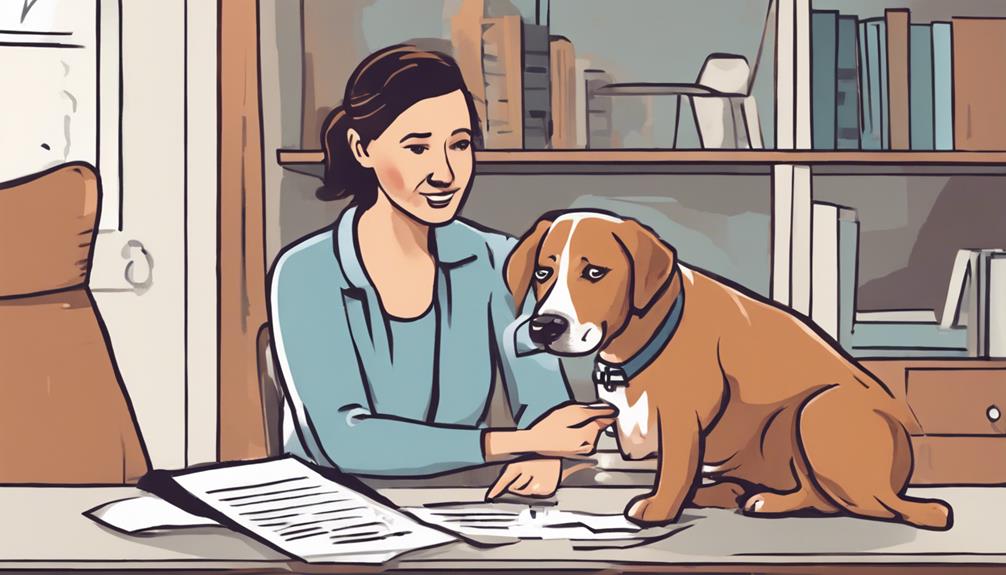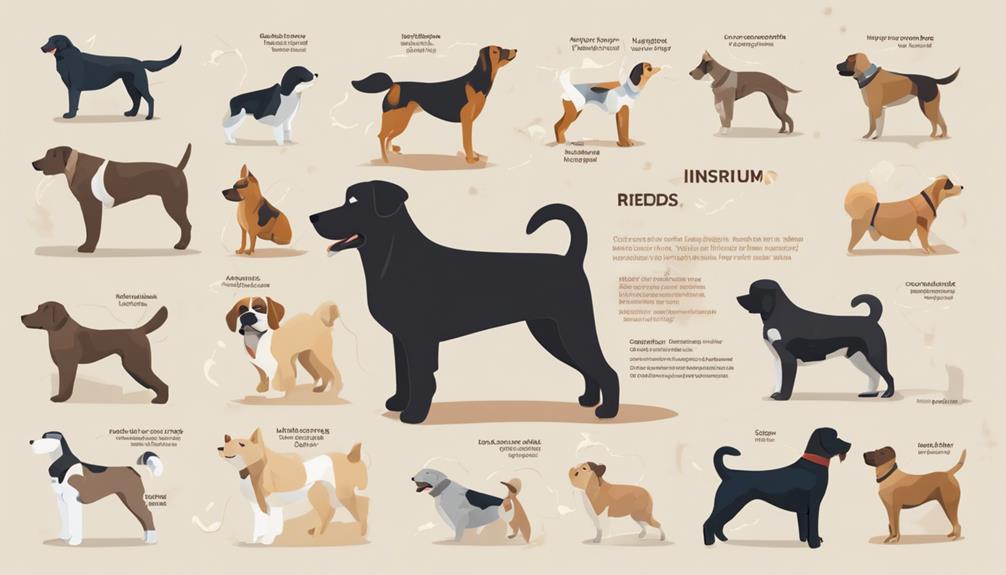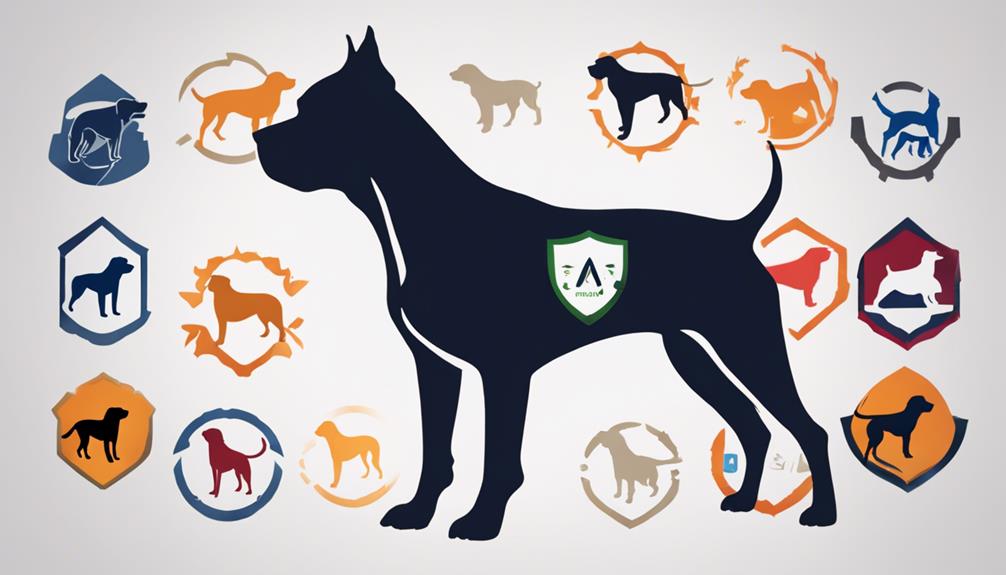15 Essential Tips for Insuring High-Risk Dog Breeds
When insuring high-risk dog breeds, it's crucial to understand breed classifications, research specialized insurance policies, and evaluate liability coverage. Behavioral training, assessing premium costs, and reviewing exclusion clauses are key steps. Explore medical coverage options, consider specialized care plans, and be aware of breed-specific legislation. Verify coverage for pre-existing conditions and assess the reputation of insurance providers. Understand the claims process, review policy renewal terms, and consider additional coverage options. Lastly, comparing quotes from multiple insurers ensures comprehensive protection. Mastering these essential tips will safeguard your pet and your financial well-being.
Understand High-Risk Breed Classifications
If you're considering insuring a high-risk dog breed, understanding the classifications is crucial to making informed decisions. When it comes to high-risk dog breeds, it's essential to recognize the various breed classifications and associated risk factors. These classifications are typically based on the likelihood of a dog breed being involved in incidents such as bites or attacks. By understanding these classifications, you can better assess the potential risks and insurance needs for your furry companion.
Dog breeds are often categorized as high-risk based on factors such as size, temperament, and history of aggression. Breeds like Pit Bulls, Rottweilers, and German Shepherds are commonly considered high-risk due to their strength and protective instincts. Understanding these breed classifications can help you assess the level of risk associated with your dog and determine the appropriate insurance coverage needed to protect yourself and others in case of an incident.
Risk factors such as a dog's history of aggression, socialization, and training play a significant role in determining the insurance requirements for high-risk breeds. Insurance companies often take these factors into account when assessing the level of risk associated with insuring a specific dog breed. By being aware of these risk factors and understanding breed classifications, you can make more informed decisions when it comes to insuring your high-risk dog breed.
Research Breed-Specific Insurance Policies
When researching breed-specific insurance policies for your high-risk dog breed, consider consulting with insurance providers that specialize in coverage tailored to your pet's needs. These specialized insurance companies understand the unique risks associated with certain breeds and can offer policies that cater to those specific needs.
Here are some key points to keep in mind when researching breed-specific insurance policies:
- Breed Specific Training Programs: Look for insurance policies that may offer discounts or incentives for participating in breed-specific training programs. These programs can help mitigate behavioral risks associated with your high-risk breed and may lead to lower insurance premiums.
- Health and Wellness Benefits: Consider insurance policies that include coverage for health and wellness benefits tailored to your dog's breed. This can include coverage for genetic conditions common in high-risk breeds, regular check-ups, vaccinations, and other preventive care measures.
- Specialized Coverage: Seek out insurance providers that offer specialized coverage options for high-risk breeds. This can include coverage for third-party liability, medical expenses, and legal fees in case of an incident involving your dog. Ensure that the policy is comprehensive and addresses the specific needs of your breed.
Evaluate Coverage for Liability Risks
Consider assessing the adequacy of your coverage for liability risks associated with owning a high-risk dog breed. When it comes to insuring breeds that are considered high-risk, such as Pit Bulls or Rottweilers, understanding your liability limits is crucial. Liability limits determine the maximum amount your insurance provider will pay out for damages or injuries caused by your dog. It's essential to evaluate whether your existing coverage adequately protects you in the event of a liability claim.
Additionally, be aware of coverage exclusions that may apply to your policy. Some insurance companies may have specific exclusions for certain breeds or types of dogs, which could leave you vulnerable to significant financial losses if an incident occurs. Make sure to review your policy carefully to understand any limitations or exclusions that could impact your coverage.
Consider Behavioral Training Requirements
Assessing the behavioral training requirements for your high-risk dog breed is key to ensuring a safe and responsible ownership experience. High-risk dog breeds often require specialized training techniques and behavioral modification to help them become well-adjusted and obedient pets.
Here are some essential tips to consider when addressing the behavioral training needs of your high-risk dog breed:
- Early Socialization: Introduce your high-risk dog breed to various people, animals, and environments from a young age. This helps them learn appropriate behaviors and reduces the likelihood of aggression or fear-based reactions.
- Consistent Training: Establish clear rules and boundaries early on and consistently reinforce them. High-risk dog breeds thrive on consistency, so regular training sessions are crucial to their development.
- Positive Reinforcement: Use positive reinforcement techniques such as treats, praise, and toys to reward good behavior. This encourages your high-risk dog breed to repeat desired actions and builds a strong bond between you and your pet.
Assess the Cost of Premiums
Evaluate the affordability of insurance premiums for your high-risk dog breed to ensure adequate coverage and financial protection. When insuring a high-risk breed, it's crucial to conduct a thorough premium comparison across different insurance providers. By obtaining quotes from various companies, you can identify the most cost-effective option that still offers comprehensive coverage for your furry companion.
Risk assessment is a fundamental aspect when determining the cost of premiums for high-risk dog breeds. Insurance companies take into account various factors such as the breed's history of aggression, bite incidents, and overall temperament. Understanding how these risk factors influence the cost of premiums can help you make an informed decision when selecting an insurance policy.
Before committing to a specific insurance plan, carefully review the coverage details to ensure it aligns with your dog's needs and your budget. While it's essential to find an affordable premium, it's equally important to prioritize sufficient coverage for potential liabilities. Balancing cost and coverage will provide you with the peace of mind that both your dog and finances are protected in case of any unforeseen incidents.
Review Exclusion Clauses Carefully
When reviewing exclusion clauses for your high-risk dog breed insurance policy, it's crucial to carefully examine the specific situations or conditions where coverage may not apply. Understanding the exclusions in your policy is essential to avoid any surprises or gaps in coverage that could leave you financially vulnerable.
Exclusion Clauses: Take note of any specific exclusion clauses related to your dog's breed history. Some insurance providers may exclude coverage for certain breeds with a known history of aggression or behavior issues. Make sure you're aware of these exclusions to understand the limitations of your policy.
Policy Limitations: Be aware of any general limitations in your policy that may affect coverage for high-risk dog breeds. Understand the extent to which your insurance provider will cover incidents related to your dog's behavior, especially if it has a reputation for being aggressive or prone to causing harm.
Breed Behavior: Familiarize yourself with the behavioral tendencies associated with your dog's breed. Insurance policies may have exclusions or limitations based on the perceived risk associated with certain breeds. Knowing your dog's behavior traits can help you anticipate any potential coverage issues and make informed decisions.
Explore Options for Medical Coverage

Consider exploring various options for medical coverage for your high-risk dog breed to ensure comprehensive protection. When insuring a high-risk breed, it's crucial to have medical coverage that not only caters to routine care but also accounts for any potential health issues that may arise. High-risk dog breeds often require specialized care, which can be costly without proper insurance. Look for insurance plans that cover a wide range of medical services, including emergency care, surgeries, and medications specific to your dog's breed.
Behavioral modification is an essential aspect to consider when exploring medical coverage for your high-risk dog breed. Some breeds may have specific behavioral tendencies that could lead to accidents or injuries, making coverage for behavioral training a valuable addition to your insurance plan. Training requirements for high-risk breeds are often more intensive, and having coverage for professional training sessions can help address any behavioral issues proactively.
Ensure that the medical coverage you choose includes preventive care such as vaccinations, regular check-ups, and screenings. These preventative measures can help catch any potential health concerns early, saving you money on extensive treatments in the long run. By investing in a comprehensive medical insurance plan that covers behavioral modification and training requirements, you can provide your high-risk dog breed with the necessary care while protecting yourself from unexpected financial burdens.
Look Into Breed-Specific Legislation
Looking into breed-specific legislation can provide valuable insights into legal requirements and restrictions that may impact owning a high-risk dog breed. Understanding the legal implications and potential breed discrimination that may exist in your area is crucial for responsible dog ownership. Here are some key points to consider:
- Legal Implications: Breed-specific legislation often targets specific breeds deemed as high-risk, imposing restrictions or requirements on owners. Familiarize yourself with any laws or regulations that may apply to your dog breed to ensure compliance and avoid legal issues.
- Community Impact: These laws are often enacted due to concerns about public safety and the impact certain breeds may have on communities. It's important to consider how owning a high-risk dog breed may affect your neighbors, local businesses, and overall community dynamics.
- Dog Ownership: Breed-specific legislation can influence your experience as a dog owner, affecting where you can live, how you socialize your pet, and what responsibilities you have towards others. Stay informed about any breed-specific regulations to navigate dog ownership successfully while being a responsible member of your community.
Check for Coverage of Pre-Existing Conditions

To ensure comprehensive protection for your high-risk dog breed, it's crucial to verify coverage for any pre-existing conditions in your insurance policy. High-risk dog breeds often come with specific health concerns that may be considered pre-existing by insurance providers. Pre-existing conditions refer to any health issues your dog had before the insurance policy's start date. It's essential to check if your insurance plan covers these conditions to avoid any surprises or potential financial burdens down the road.
When selecting insurance for your high-risk breed, inquire about the coverage of pre-existing conditions. Some insurance companies may offer coverage for pre-existing conditions, while others may exclude them from the policy. Understanding the terms and limitations regarding pre-existing conditions in your insurance policy is vital for making informed decisions about your pet's healthcare.
Having coverage for pre-existing conditions can provide you with peace of mind knowing that your dog's existing health issues are included in the insurance plan. This coverage can help offset the costs of ongoing treatments, medications, or vet visits related to these conditions. Before finalizing your insurance choice, thoroughly review the policy documentation or speak directly with the insurance provider to ensure you have a clear understanding of what's covered regarding pre-existing conditions for your high-risk dog breed.
Consider the Reputation of the Insurance Provider
Exploring the reputation of your chosen insurance provider is essential when safeguarding your high-risk dog breed's well-being and financial security. Your dog's safety and your peace of mind rely on the reliability of the insurance company you select. Here are some crucial steps to take when evaluating the reputation of an insurance provider:
- Research customer reviews: Look into what other pet owners, especially those with high-risk dog breeds, have to say about their experiences with the insurance company. Pay attention to reviews that mention how the company handles claims related to high-risk breeds. This firsthand information can give you valuable insights into the provider's trustworthiness and customer service.
- Compare pricing options: While affordability is important, it shouldn't be the sole factor in your decision-making process. Compare the pricing options of different insurance providers to ensure you're getting a reasonable premium for the coverage offered. Keep in mind that the cheapest option may not always provide the best coverage for your high-risk dog breed.
- Check industry ratings: Look for independent ratings and reviews from reputable sources within the insurance industry. High ratings from organizations that assess insurance companies can indicate the provider's financial stability and reliability in handling claims.
Understand the Claims Process

Understanding the claims process is crucial for effectively managing the insurance coverage for your high-risk dog breed. When it comes to insuring high-risk breeds, such as pit bulls or Rottweilers, being well-versed in the claims process can make a significant difference in ensuring that you receive the necessary support in times of need. Claims process efficiency is a key factor that directly impacts customer satisfaction.
Efficient claims processing is essential for high-risk dog breeds as these breeds may have a higher likelihood of being involved in incidents that require insurance coverage. Familiarize yourself with the specific steps involved in filing a claim with your insurance provider. This includes understanding what documentation is required, how long the process typically takes, and what you can expect in terms of reimbursement or coverage.
Assess the Level of Customer Support
Navigating the insurance process for high-risk dog breeds can be challenging, and a key aspect to consider is evaluating the level of customer support provided by your insurance provider. When insuring your high-risk dog breed, the support you receive can make a significant difference in your overall experience.
Here's what you should look for when assessing the level of customer support:
- Customer Service: Prompt and helpful customer service is crucial when dealing with insurance matters related to high-risk dog breeds. Ensure that your insurance provider offers responsive assistance and clear communication channels to address any queries or concerns you may have during the claims process.
- Claims Process Support Options: Evaluate the support options available to you when navigating the claims process. A reliable insurance provider should offer guidance and assistance to help you understand the steps involved, making the process smoother and less stressful for you.
- Policy Renewal: Consider how the insurance provider handles policy renewal. Look for a provider that offers transparent information on policy renewal terms, options for adjustments based on your needs, and assistance in renewing your policy without unnecessary complications. A provider that prioritizes policy renewal support can ensure that you maintain coverage for your high-risk dog breed without added stress.
Review Policy Renewal Terms

When reviewing policy renewal terms for insuring your high-risk dog breed, prioritize clarity and understanding to ensure seamless continuation of coverage. It's crucial to carefully assess the policy flexibility offered by your insurance provider. Understanding the renewal terms will help you anticipate any changes in coverage limitations that may affect your high-risk dog breed.
As you delve into the renewal options, pay close attention to any modifications in the policy that could impact your coverage. Some insurance companies might adjust their renewal terms based on your dog's breed and any past incidents. By being aware of these potential changes, you can make informed decisions regarding your policy renewal.
Policy flexibility plays a significant role in ensuring that your high-risk dog breed remains adequately covered. Look for insurance providers that offer options to adjust your coverage based on your evolving needs. This flexibility can be particularly beneficial for high-risk breeds, as it allows you to tailor your policy to address specific concerns related to your dog's breed.
Consider Additional Coverage Options
To ensure comprehensive protection for your high-risk dog breed, exploring additional coverage options can be a strategic way to enhance your insurance policy. When it comes to insuring breeds that are considered high-risk, it's crucial to consider all possible scenarios and ensure you have adequate coverage in place.
Here are some key factors to keep in mind when considering additional coverage options:
- Coverage Limits: High-risk dog breeds may come with higher liability risks. It's essential to review your policy's coverage limits to ensure they're sufficient to protect you in case of any incidents involving your dog. If the standard liability limits aren't enough, consider increasing them to provide better financial protection.
- Policy Customization: Not all insurance policies are created equal, and when it comes to high-risk dog breeds, customization is key. Look for insurers that offer the flexibility to tailor your policy to suit your specific needs. This could include adding extra liability coverage, animal behavior training coverage, or coverage for damage caused by your dog.
- Specialized Coverage: Some insurance providers offer specialized coverage options for high-risk dog breeds. These additional coverages may include coverage for legal expenses if your dog is involved in an incident, coverage for veterinary bills resulting from an incident, or even coverage for alternative accommodation if your home becomes uninhabitable due to a dog-related incident.
Compare Quotes From Multiple Insurers

Consider obtaining quotes from multiple insurers to ensure you find the most competitive and suitable coverage for your high-risk dog breed. Policy comparison is crucial when insuring breeds that are often categorized as high-risk due to their past behavior or perceived tendencies. By gathering quotes from various insurers, you can compare not only the cost but also the extent of coverage each policy provides. This step is essential in making an informed decision that meets both your dog's needs and your budget.
When embarking on the insurer selection process, it's vital to look beyond just the premium amount. Different insurers may offer varying levels of coverage, deductibles, and exclusions. By comparing quotes, you can identify the policy that not only fits your financial constraints but also offers the best protection for your high-risk dog breed. Remember, the cheapest option may not always provide the comprehensive coverage your furry friend requires.
Insurer selection is a critical aspect of ensuring your high-risk dog breed is adequately protected. Take the time to research each insurer's reputation, customer service, and claims process in addition to comparing quotes. Opting for a reliable insurer with a history of handling claims fairly and efficiently can give you peace of mind in knowing that you're well-covered in case of any incidents involving your beloved pet.
Frequently Asked Questions
Can I Insure a High-Risk Dog Breed if It Has a History of Aggression?
If your dog has a history of aggression, insuring a high-risk breed can be challenging. However, by focusing on behavior modification and a thorough risk assessment, insurance companies may be more willing to provide coverage.
Implementing training and socialization programs can help improve your dog's behavior and demonstrate to insurers that you're actively working to address any potential risks. Be prepared to provide documentation and evidence of your efforts to mitigate aggression.
Will My Insurance Cover Damages Caused by My Dog Outside of My Property?
Your insurance may have coverage limits for damages caused by your dog outside of your property, so be sure to check your policy.
Some insurance companies also impose breed restrictions, especially for high-risk dog breeds.
Understanding your policy terms and discussing any concerns with your insurance provider can help you navigate potential liabilities.
Stay informed to ensure you have the necessary coverage for your furry companion.
Are There Specific Training Certifications That Can Lower My Premiums?
To lower your premiums, consider obtaining training certifications for your dog. These certifications can showcase your dog's good behavior and reduce the perceived risk for insurance companies, leading to potential premium discounts.
Training certifications not only benefit your dog's behavior but also demonstrate responsibility as a pet owner. By investing in training, you can proactively mitigate risks and potentially save on insurance costs in the long run.
How Does the Insurance Handle Incidents Involving Multiple High-Risk Dog Breeds?
When it comes to incident management involving multiple high-risk dog breeds, insurance typically considers various factors like the breeds involved, the severity of the incident, and any previous history.
Breed combinations can impact how claims are handled. It's essential to have clear documentation and details about the incident to help the insurance company assess the situation accurately.
Being proactive and transparent can aid in smoother claim processing and resolution.
Is There Coverage for Legal Fees in Case of a Dog-Related Lawsuit?
If you're wondering about coverage for legal fees in a dog-related lawsuit, the insurance typically provides liability protection. This means that you can receive financial assistance for legal representation and lawsuit expenses that may arise as a result of a dog-related incident.
It's essential to review your policy details to understand the extent of this coverage and ensure you're adequately protected in case of a legal dispute involving your high-risk dog breed.
Conclusion
You've taken the necessary steps to insure your high-risk dog breed, ensuring you have the right coverage in place. By understanding breed classifications, researching policies, evaluating liability risks, and considering training requirements, you've set yourself up for success.
Remember to compare quotes, assess customer support, and review renewal terms regularly to ensure you have the best protection for your furry friend. With these essential tips, you can have peace of mind knowing your dog is covered.
